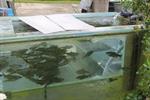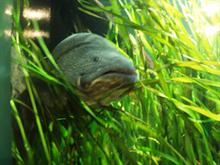- Discuss the scope and nature of aquarium use and management
- Describe the Water Ecosystem
- Explain Water Quality and Management
- Determine appropriate equipment and systems for different applications in the provision of aquaria.
- Determine appropriate species of animal and plant life to introduce into an aquarium
- Explain the establishment of a freshwater aquarium
- Explain the establishment of a saltwater aquarium
- Explain the maintenance of an aquarium
- Explain how to breed a range of different fish
WHAT IS AN AQUARIUM?
 An aquarium is basically an underwater ecosystem.
An aquarium is basically an underwater ecosystem.
In order to maintain similar conditions to the natural environment and habitat of the species that live in the tank, it is necessary to maintain constant water conditions as well as optimal water quality levels specifically required by each organism in the aquarium tank. To reach these conditions, it is essential to be familiar with the right type of equipment in order to supply the appropriate environmental conditions that each species requires.
Whether you choose to have a saltwater tank or a freshwater tank, you will need to take care and protect your system and equipment, however, as salt is a corrosive agent, a freshwater tank may be more recommended for beginners because it may be easier to maintain.
An aquarium can be as simple as a small round tank with a single fish inside to a large tank with a variety of fish, species and ornaments to help create an ecosystem that can be very pleasing to watch and care for. Those with a broad variety of species are often called “community tanks”, which can be quite a learning experience in terms of watching different interactions within the different species kept. However, taking into account the compatibility within the species is a very important factor to consider if you wish to maintain harmony between the species and the environment inside an aquarium tank.
What to Grow in an Aquarium?
 Among the behavioural problems, fish that are slow swimmers might get disturbed by those that swim fast, or the size of a larger fish might intimidate a smaller one, provoking the small one to exhibit aggressive behaviour. Aggressive fish are most likely to eat more food than those that are shy, but adding more food won’t help either because that will only accumulate more uneaten food in the tank, which can lead to water quality problems. Different types of fish might fight for territory and limit the amount of space for the rest of the fish to swim free. If there’s not enough ornamental structures which fish can use for hiding, the territorial ones might use the only ones available in the tank.
Among the behavioural problems, fish that are slow swimmers might get disturbed by those that swim fast, or the size of a larger fish might intimidate a smaller one, provoking the small one to exhibit aggressive behaviour. Aggressive fish are most likely to eat more food than those that are shy, but adding more food won’t help either because that will only accumulate more uneaten food in the tank, which can lead to water quality problems. Different types of fish might fight for territory and limit the amount of space for the rest of the fish to swim free. If there’s not enough ornamental structures which fish can use for hiding, the territorial ones might use the only ones available in the tank.
It is also necessary to find out if the species you are planning to include have the same water quality and food requirements so they can live in a well-balanced environment altogether. If a fish isn’t compatible with the parameters present in the water (for example: temperature, salinity, oxygen levels, alkalinity, pH, etc.), its colours or its growth rate might be diminished. It’s important, as well, to avoid overcrowding because this may lead to stress as well as low water quality issues.
Other living organisms that are very important to have in an aquarium are aquatic plants. These regulate important chemical balances such as the nitrogen cycle, as well as oxygenating the water. They also serve as shelter for fish and other invertebrates and helps give the aquarium a natural look. Many aquarists maintain a diverse range of aquatic plants as part of the `aquascape’ of their tank. This requires growing, propagating, fertilising and maintaining their plants on a weekly basis. Some aquarium fish and invertebrates also eat live plants, so aquarists may want to take this into account when matching up fish and plant species in the same tank. A lush aquascape of vegetation can be hard to maintain if fish and snails are consuming plant foliage as fast as it grows. Or plant material may be propagated and grown in a separate `plants only’ tank for regular replacement into aquariums stocked with fish to act as an additional food source for species who like to nibble on plant material.
Some plants assist certain fish species during the breeding process and may be used as part of breeder tanks. Java Moss and other types of dense spreading plants act as a safe haven for fry, preventing them from being eaten by adults.
Freshwater and Saltwater are the two basic and most common types of aquatic tanks. There is also a third common type referred to as “brackish water”, which is a mix between these two types of aquatic environments, resembling an estuary, river mouth or a mangrove in nature. But for small scale aquarists (home, hobbyist, restaurant, etc), this term falls into the category of a freshwater aquarium tank.